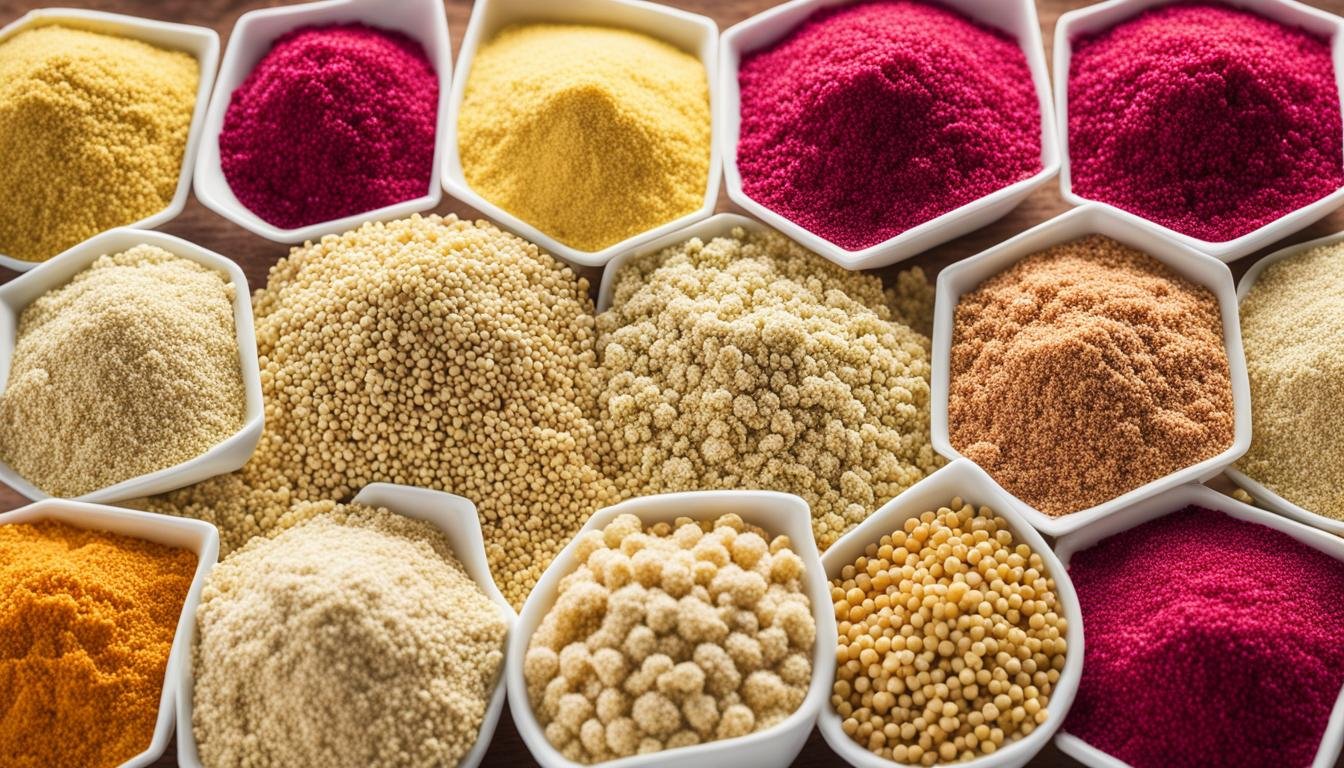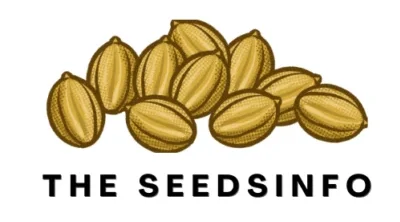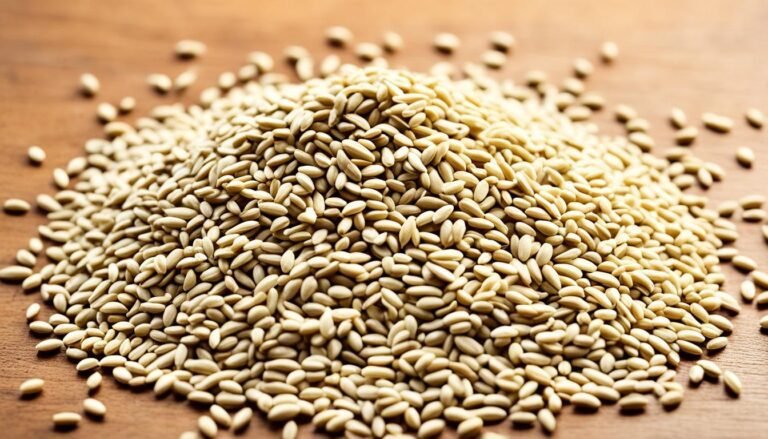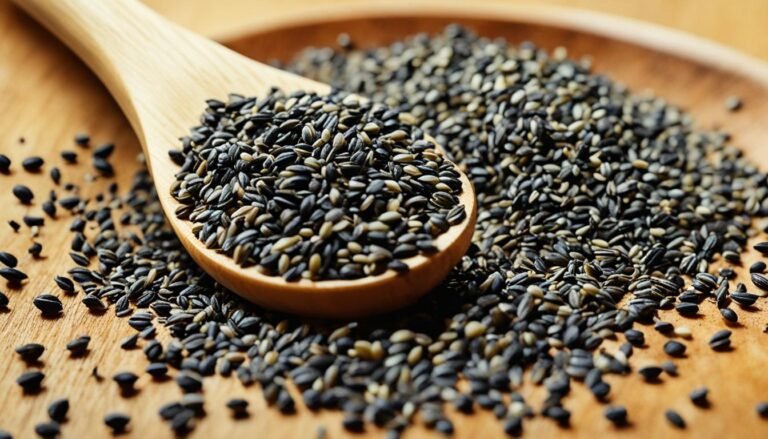Amaranth Products: Market Trends and Demand

Did you know the global amaranth market was worth US$ 9.2 billion in 2022? It’s expected to hit US$ 24.6 billion by 2032, growing at a 10.3% CAGR. This growth is thanks to amaranth’s health benefits and its nutrient-rich profile.
Now, you’ll find more amaranth products in stores, from baked goods to skincare. This is because amaranth is gluten-free, high in protein, and packed with vitamins and minerals. It’s becoming a key player in the health food market.
Amaranth’s uses go beyond cooking. It’s also in cosmetics for its nutrients and antioxidants. These help keep skin healthy and reduce wrinkles. This broad appeal is boosting demand for amaranth products in various industries.
Introduction to Amaranth: The Ancient Superfood Grain
What is Amaranth and its Origins
Amaranth is a type of plant with broad leaves, part of a group of plants that include annuals and short-lived perennials. It’s also known as pigweed. People grow it as a leaf vegetable, a grain-like seed, and for its beauty. For centuries, it has been valued for its nutritional value and spiritual significance by the Aztecs and Incas.
Nutritional Profile and Health Benefits of Amaranth
Amaranth is packed with antioxidants, protein, carbs, calcium, and other nutrients, making it a superfood. It’s like a pseudo-cereal because it has a nutritional profile similar to grains like wheat and rice. Its flowers produce tiny grain-like buds, which classify it as a grain.
It’s gluten-free and can help lower cholesterol and blood pressure. Amaranth also has anti-inflammatory properties and can fight cancer. It’s a great source of protein, fiber, and can boost your immune system.
| Nutrient | Amount per 100g |
|---|---|
| Protein | 15g |
| Carbohydrates | 65g |
| Fiber | 7g |
| Calcium | 159mg |
| Iron | 7.6mg |
| Magnesium | 248mg |
| Phosphorus | 557mg |
| Potassium | 508mg |
| Zinc | 2.9mg |
Amaranth is a nutrient-rich food that can improve your diet. It’s high in protein, amino acids, and minerals and vitamins. This makes it a true superfood grain.
Global Amaranth Market: Size, Growth, and Projections
The global amaranth market is growing fast, and it will keep getting bigger. Fact.MR predicts a 10.3% growth rate from 2022 to 2032. This is thanks to more people seeing amaranth as a health food and its use in functional foods.
In 2021, the market was worth USD 5.89 billion. It’s set to grow a lot over the next few years. Amaranth seeds lead the market, used in many foods from main dishes to desserts. The cosmetic and personal care segment is also growing fast, thanks to amaranth oil’s skin benefits.
| Segment | Market Share (2021) | Projected CAGR (2022-2032) |
|---|---|---|
| Amaranth Seeds | 53% | 11.2% |
| Amaranth Oil | 30% | 10.8% |
| Amaranth Flour | 17% | 9.5% |
North America led the market in 2021, and it will keep leading. This is because of a focus on healthy and gluten-free foods there. The Asia Pacific region is growing the fastest, thanks to a booming cosmetics industry and higher incomes in countries like China and India.
The amaranth market has a few big players because making it is expensive. Companies like Amaranth Bio Company and AMR Amaranth A.S. are major names. Despite strong competition, new investments are coming in, showing confidence in the market’s future.
Market trends and demand for Amaranth products
More people want natural and organic products, pushing the amaranth market up. They’re choosing vegan supplements too. Also, eating more functional foods and drinks helps the market grow. Plus, learning about amaranth’s benefits and new cosmetics products are making the market bigger.
Drivers Fueling the Growth of Amaranth Market
Several factors are making amaranth products more popular:
- Increasing Health Consciousness: People care more about their health and want foods and products that are good for them.
- Rising Demand for Vegan and Gluten-Free Options: More people are choosing plant-based and gluten-free products, making amaranth more in demand.
- Expanding Distribution Channels: Amaranth products are now easier to find in stores, online, and in health food shops.
- Innovation in Product Formulations: New and creative amaranth products are being made, like foods and skincare items.
- Increasing Awareness of Amaranth’s Benefits: More people are learning about amaranth’s health benefits through education and media.
These factors, along with a desire for natural and organic products and vegan supplements, are boosting the amaranth market. People are eating more functional foods and drinks, which helps the market grow.
| Amaranth Oil Market Statistics | Value |
|---|---|
| Compound Annual Growth Rate (CAGR) (2024-2031) | 11.6% |
| Market Size (2031) | $1,837.68 million |
| Market Size (2023) | $763.76 million |
| Extraction Types | Supercritical Fluid CO2, Cold Pressing, Organic Solvent (Hexane) |
| Key Applications | Cosmetics and Personal Care, Dietary Supplements, Aromatics, Pharmaceuticals |
| Key Regions | North America, Europe, Asia-Pacific, South America, Middle East & Africa |
The amaranth oil market is growing fast, with a 11.6% CAGR from 2024 to 2031. It’s expected to hit $1,837.68 million by 2031, up from $763.76 million in 2023. This growth is thanks to a higher demand for natural and organic products and vegan supplements. Amaranth oil is versatile, used in cosmetics, personal care, supplements, and pharmaceuticals.
Key Applications Driving Amaranth Consumption
Food and Beverage Industry: Amaranth in Baked Goods, Cereals, and Snacks
Amaranth is a big player in the food and beverage industry. It’s in high demand because people want healthy, plant-based foods. You can find amaranth flour in many bakery items like cookies, bread, noodles, and pancakes.
In India, amaranth is eaten during fasts because it’s a great source of energy. The food industry is expected to grow fast, thanks to more people choosing natural ingredients.
This growth is also driven by the use of amaranth in personal care products. It’s versatile, used as both a grain and a vegetable. This is helping its market expand, especially in North America and Europe.
Amaranth comes in different forms like seeds, oil, leaves, and flour. These are used in food, pharmaceuticals, personal care, and more. The food industry uses the most amaranth, followed by personal care products.
| Amaranth Product | Key Applications |
|---|---|
| Amaranth Flour | Cookies, breads, noodles, pancakes |
| Amaranth Leaves | Salads, stir-fries, curries |
| Amaranth Oil | Cosmetics, personal care products |
| Amaranth Grains | Cereals, snacks, traditional dishes |
The cosmetics and personal care industry also uses amaranth oil. It’s great for beauty products because it fights aging, protects against damage, and reduces inflammation. Amaranth is becoming more popular for its health benefits, pushing its use in food, drinks, and personal care products.

Regional Analysis: Hotspots for Amaranth Production and Consumption
The global amaranth market is diverse, with key regions leading in production and consumption. Let’s explore the main trends in the amaranth industry.
North America: Dominating the Market
North America leads the amaranth market with a 26.2% share. This is due to a growing demand for organic and natural products. Also, vegan supplements with amaranth are becoming more popular.
Europe: Innovative Amaranth Applications
Europe has a 23.3% share of the amaranth market. The region is seeing more awareness of amaranth’s benefits. This has led to new products in the cosmetics industry, boosting the market.
Asia Pacific: Promising Growth Ahead
The Asia Pacific region is set for big growth. Countries like India, China, and Japan love amaranth as a delicacy. Its use in diverse cuisines and health trends are driving demand.
| Region | Market Share | Key Drivers |
|---|---|---|
| North America | 26.2% | Rising demand for naturally derived and organic products, growing popularity of vegan supplements |
| Europe | 23.3% | Increasing awareness about the benefits of amaranth, burgeoning trend in the cosmetics industry |
| Asia Pacific | Significant growth anticipated | High consumption rate of amaranth as a delicacy, diverse culinary traditions, increasing health consciousness |
These regional hotspots show how the amaranth market is changing. They highlight the key factors and trends in this superfood’s growth.
Competitive Landscape: Major Players in the Amaranth Market
The global amaranth market is filled with key players who are pushing innovation and changing the industry. These leading brands are using different strategies to improve their market standing and meet consumer needs.
Strategies Adopted by Leading Amaranth Brands
Major players in the amaranth market use various marketing tactics. They focus on developments, alliances, and agreements. They also create new products and improve existing ones to stand out to consumers. For example, in 2019, Epicurean Dairy UK Ltd. introduced Brekkie. It’s a breakfast option with unsweetened yogurt, puffed buckwheat, fruit compote, amaranth, quinoa, and linseed granola grains.
Other strategies include:
- Expanding their product lines with new amaranth-based items to meet different consumer needs.
- Creating partnerships to use each other’s strengths and enter new markets.
- Investing in research to make unique amaranth products and boost their nutrition.
- Using sustainable sourcing and ethical manufacturing to attract eco-friendly consumers.
- Running targeted marketing campaigns to highlight the benefits of adding amaranth to daily meals.
By using these strategies, leading amaranth brands are becoming trusted and innovative in the superfood market.

| Key Players in the Amaranth Market | Strategies Adopted |
|---|---|
| Arrowhead Mills Inc. (Hometown Food Company) | Expanded product portfolio, Formed strategic partnerships |
| DK MASS sro | Invested in R&D, Focused on sustainable sourcing |
| Epicurean Dairy UK Ltd. | Launched innovative amaranth-based products, Engaged in targeted marketing |
Challenges and Restraints Faced by the Amaranth Industry
The amaranth industry faces big challenges that slow its growth. One big issue is the high production cost of amaranth. This makes it hard for many companies to work in this market.
Another big problem is that amaranth doesn’t produce as much as other grains. This makes amaranth and its products more expensive. It also limits who can buy them.
Weather in places where amaranth grows is also a big problem. Bad weather can really hurt how much amaranth is made. This leads to problems in getting products to stores and makes prices go up and down.
Also, there are cheaper food colorants out there. These are easy to find and use. This makes people choose them over amaranth-based products.
| Challenge | Impact |
|---|---|
| High Production Cost | Fewer manufacturers, hampering market growth |
| Lower Crop Yield | Increased overall price of amaranth products |
| Uncertain Climatic Conditions | Supply chain disruptions and price volatility |
| Availability of Low-Cost Alternatives | Reduced demand for amaranth-based products |
The amaranth industry needs to work on these issues. They should make production better and find ways to make amaranth products more competitive and affordable.
Emerging Trends and Future Outlook for Amaranth Products
The global amaranth market is set to grow significantly in the next few years. This growth is thanks to a higher demand for healthy superfoods and a preference for natural and organic products. People are learning about amaranth’s nutritional benefits and its role in health. This has made it popular in many food and drink items.
Amaranth-based products are becoming more popular in the health and wellness sector. People want natural, plant-based foods to meet their nutritional needs. Amaranth fits this bill with its high protein, fiber, and minerals.
There’s also a trend of adding superfoods like amaranth to processed foods. This includes things like baked goods, cereals, and snacks. Companies see amaranth as a way to make their products healthier and attract health-conscious buyers.
North America and Europe are expected to see the biggest growth in amaranth use. This is because there’s a growing demand for natural and organic foods in these regions. Other regions like Asia-Pacific and Latin America are also showing interest in amaranth. This is due to urbanization, higher incomes, and awareness of superfoods.
Companies in the amaranth industry are responding to these trends with new products, partnerships, and marketing efforts. They aim to meet the growing interest in healthy and sustainable food choices. This will help them strengthen their position in the global amaranth market and shape its future.
| Emerging Trends | Future Outlook |
|---|---|
| Increasing popularity of amaranth-based health and wellness products Rising demand for amaranth as a functional ingredient in processed foods Expansion of the amaranth market in North America and Europe Rapid growth in emerging markets like Asia-Pacific and Latin America | The global amaranth market is projected to reach USD 26.35 Billion by 2031, growing at a CAGR of 8.8% from 2024 to 2031 Leading manufacturers are focusing on product diversification, strategic partnerships, and aggressive marketing to capitalize on the growing demand Increasing consumer preference for natural and organic products is expected to drive the adoption of amaranth across various industries |
The future looks bright for the amaranth market as the world moves towards healthier, natural, and sustainable living. Amaranth’s versatility, nutritional value, and growing popularity make it a key superfood for the future.
Conclusion
The global amaranth market is set to keep growing. This is thanks to its rising popularity as a health food and its many health benefits. North America, Europe, and the Asia-Pacific region are becoming key areas for making and using amaranth.
Even with high production costs and limited supply, the demand for healthy, natural, and organic products is growing. This trend is expected to boost the use of amaranth in the future. As more farmers grow this ancient grain and technology gets better, amaranth products will become more available and affordable.
The future is bright for the global amaranth market. It offers chances for both big companies and new ones to benefit from the growing interest in this superfood. As people focus more on wellness and look for natural, plant-based options, amaranth is likely to become even more popular. This will lead to more growth and new ideas in the industry.






